When I think of Nike, my mind automatically wanders to the pair of consistently out-of-stock Air Force Ones, the period drama-esque Cannes Lions-winning ads, and the iconic swoosh that’s almost an emblem for continuous action.
Today, Nike is the most successful and admired sportswear brand in the world with revenue greater than its competitors — Adidas, Puma, Reebok, and Under Armour — combined. But, how many of you remember its original moniker – Blue Ribbon Sports?
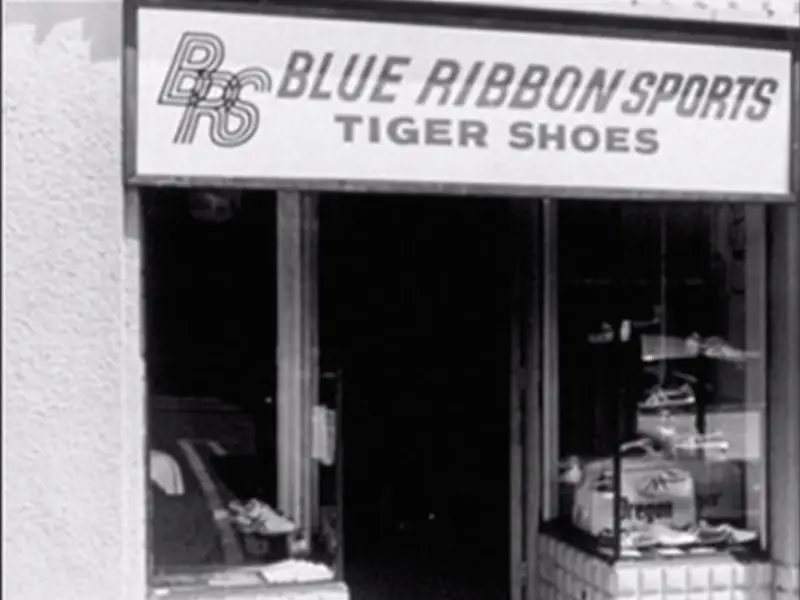
Yet, before brand Nike could – spend loads on branding, sign mercurial talent, or move as fast as they do, Blue Ribbon had to – sell shoes out of the founder’s car, build long and exhausting mailing lists, repeatedly (and unsuccessfully) request banks to extend their credit line, and do the scrappy, unimpressive, janitorial work day in day out.
There’s a lesson here for all startups. You don’t become a $100M company by doing what it does today. You become one by doing what they did to get where they are. More interestingly, you will find that 0-100 journeys are more about foundational consciousness than capital.
“What they did at the beginning – Airbnb, Uber, Etsy, and all these other big companies – is not what they’re doing now that they’re huge.”
– Thales S. Teixeira, Co-founder, Decoupling. Co and former Associate Professor, HBS
In this article, we poke holes in three early-stage assumptions:
- There is no end to tech maturity; keep building infrastructure as you go
- A more robust acquisition rigor leads to more substantial value growth
- Customer adoption is defined by how quickly your product adapts
Operating as the revenue growth management platform for 6500+ subscription businesses and having conducted research on SaaS and subscriptions, we provide counterintuitive intelligence that helps you understand that, more often than not, operational consciousness is the filtering membrane between the good and the great.
But if nothing else, this article intends to prove that growth, sometimes, lies in the mundane.
1. For your business to scale, your architecture must scale too
When successful SaaS businesses recount their origin stories, designing a functional tech architecture isn’t the first thing they discuss. However, having that resolved first frees you up to dream and dare. It helps you focus on building product and business momentum since you’ve taken care of the more minor operational issues.
In a 2020 study by Forrester Consulting, surveying 150 revenue decision makers and 50 business decision makers at subscription-based organizations, we found that while net-new sales was still a key growth driver, building solid customer experiences (CX) and process efficiency was top of mind.
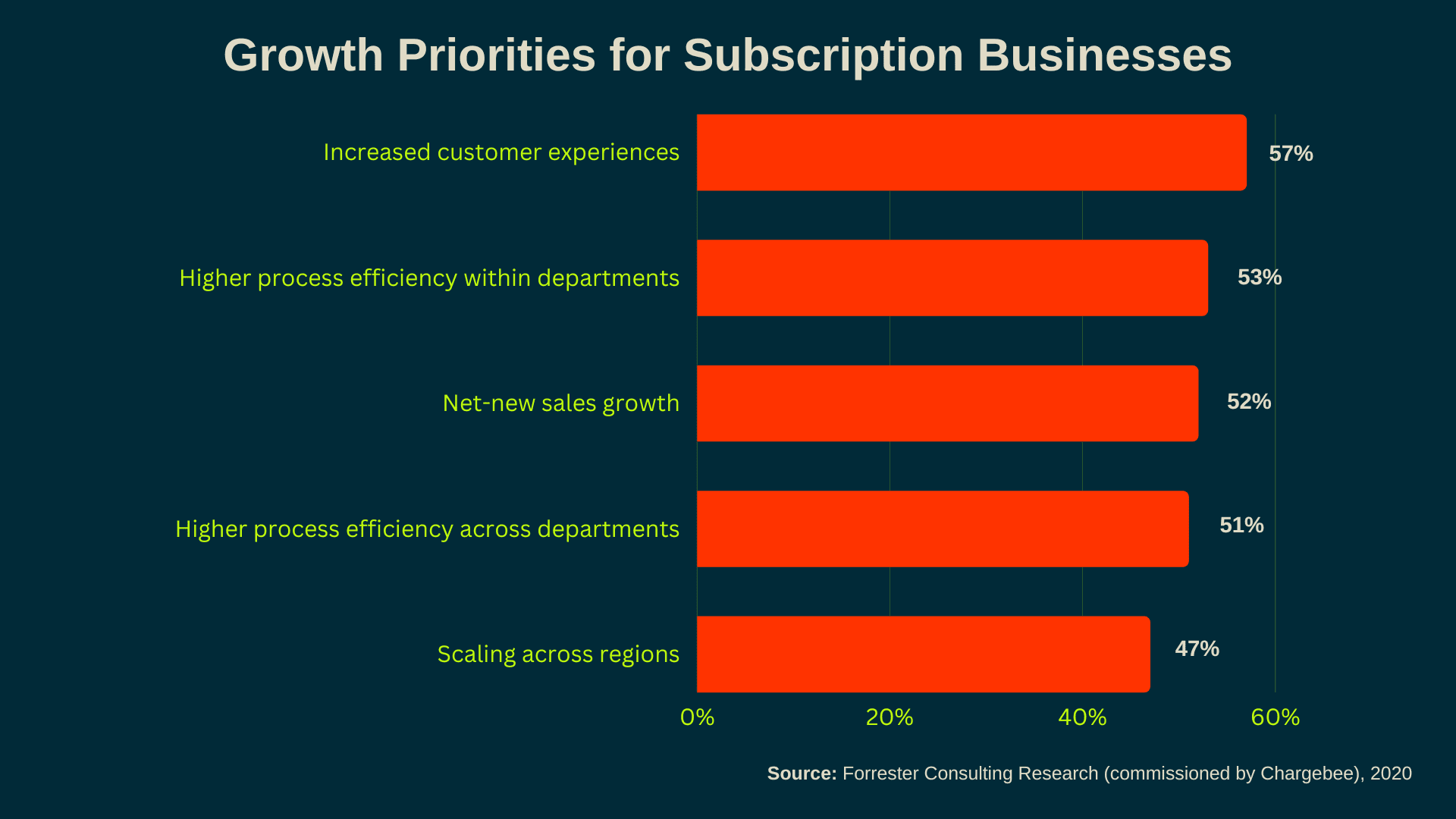
Back in 2014, Study.com had a great product ready to be monetized. The company decided to launch subscriptions with just a paywall and a payment gateway. It was a quick fix that seemed to do its job – get early customers in through the door.
Yet, as the company began growing, matters quickly became nebulous. Adding every new customer required the accounting team to spend more time creating and sending invoices, answering billing queries, and maintaining records. They had to manually configure every new coupon code, pricing change, and product launch.
If this wasn’t enough, Study.com’s plans to build a larger net addressable market (NAM) and launch multiple courses only multiplied the problem of setting up billing, invoicing, prorations, coupons, pricing, and more manifold.
This reliance on a single payment gateway suddenly exposed them to a higher downtime risk. If the gateway crashed, its impact could percolate from revenue and into its operations. So, the company decided to automate every step of its revenue process – from checkout to recognition.
Chargebee sat at the heart of their subscription and revenue experiences, helped build integrations with multiple payment gateways, gave a clearer view of subscription success with crucial metrics reporting, and strengthened data-handshake between teams. It ultimately helped leaders make more strategic decisions with conviction.
Today, Study.com has five products and successfully delivers over 88,000 lessons to over 30 million customers.
An excellent revenue infrastructure, especially in the earlier stages, helps avoid jumpscares by preventing system crashes and takes away the pain of having to rethink your entire toolkit by building an operations muscle earlier.
2. Acquisition is no longer the sole needle-mover for growth
Conventionally, early-stage growth has been a function of potential over profitability. It translates into hiring sales reps, setting up an acquisition funnel, and allocating sales and marketing budgets. However, higher customer acquisitions don’t always correlate to sustained revenue growth. Not all customers who buy in will continue to remain with your business.
A streamlined focus on customer acquisitions may, therefore, (which is also at least 5X more expensive than retention) may not always be the route to sustainable growth. While acquisitions as a growth lever is a fair story during bull markets (where customers are more likely to purchase), economic tightening and downward pressures can quickly shift the tide.
SaaS growth, especially within the current market constraints, is a function of high net dollar retention (NDR) and a low CAC Payback.
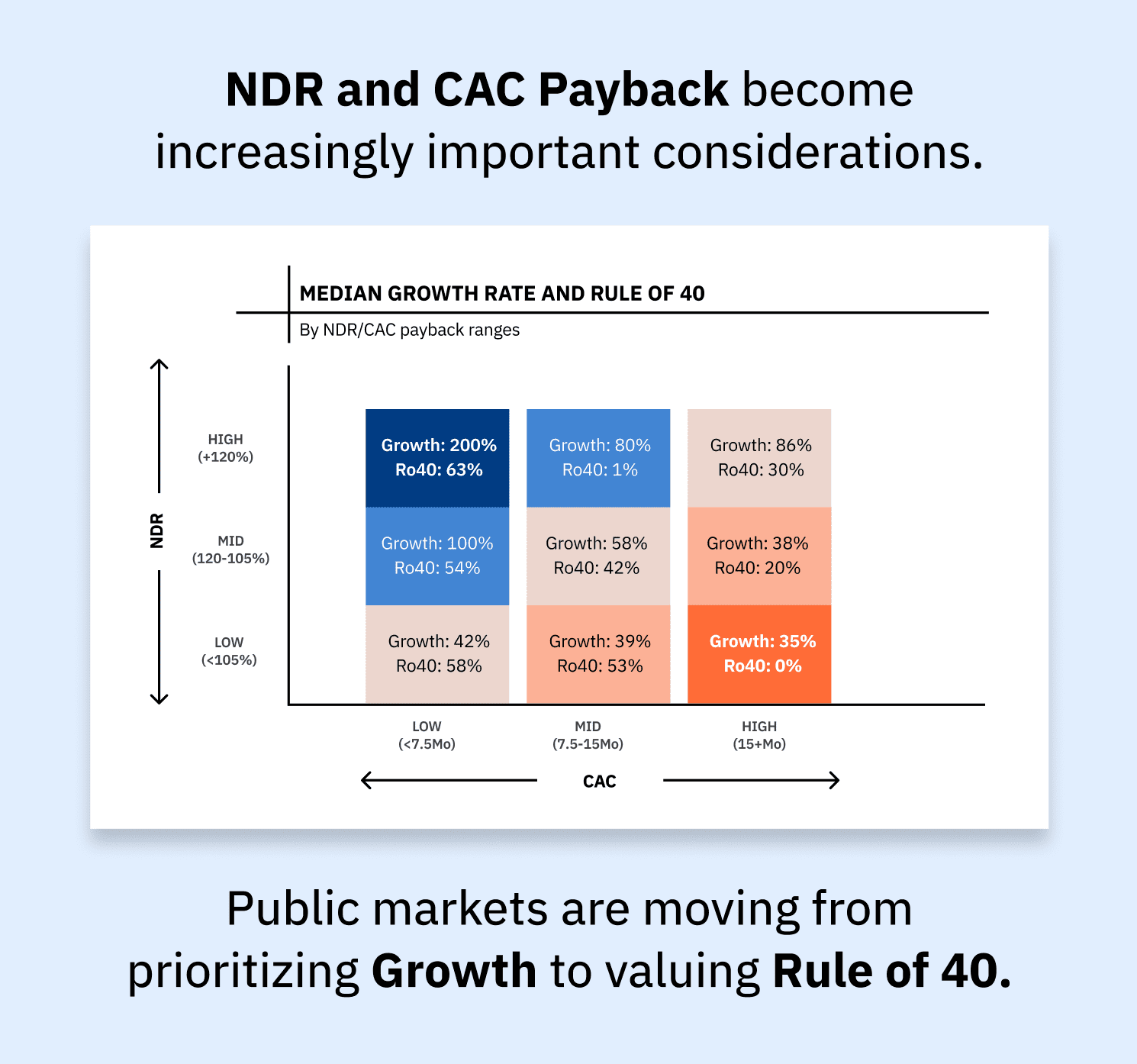
A high-performing sales-led growth motion might accelerate net-new acquisitions, but it does not guarantee a return on your customer acquisition cost (CAC). For acquisitions to trickle down into revenue impact, businesses must either reduce the CAC Payback period – i.e., be more efficient in lowering CAC, or retain customers long enough to profit.
External stimuli – competition, ad rates, or customer behavioral patterns- heavily influenced CAC. Things that you have little control over. But retention is a process question that, with the right tools, can be actively solved yet is woefully ignored.
In one of our recent webinars, Chargebee Retention raised a simple question for its attendees –
“Does your company have a published churn goal?”
23% did. 68% did not.
Unsurprisingly, when we dived into retention performance, we found monthly customer churn (across industries) was higher in 2022 than in 2021. Sure, high-interest rates, heightened customer caution, and smaller wallets were a reason. But the minimal focus on retention didn’t help.
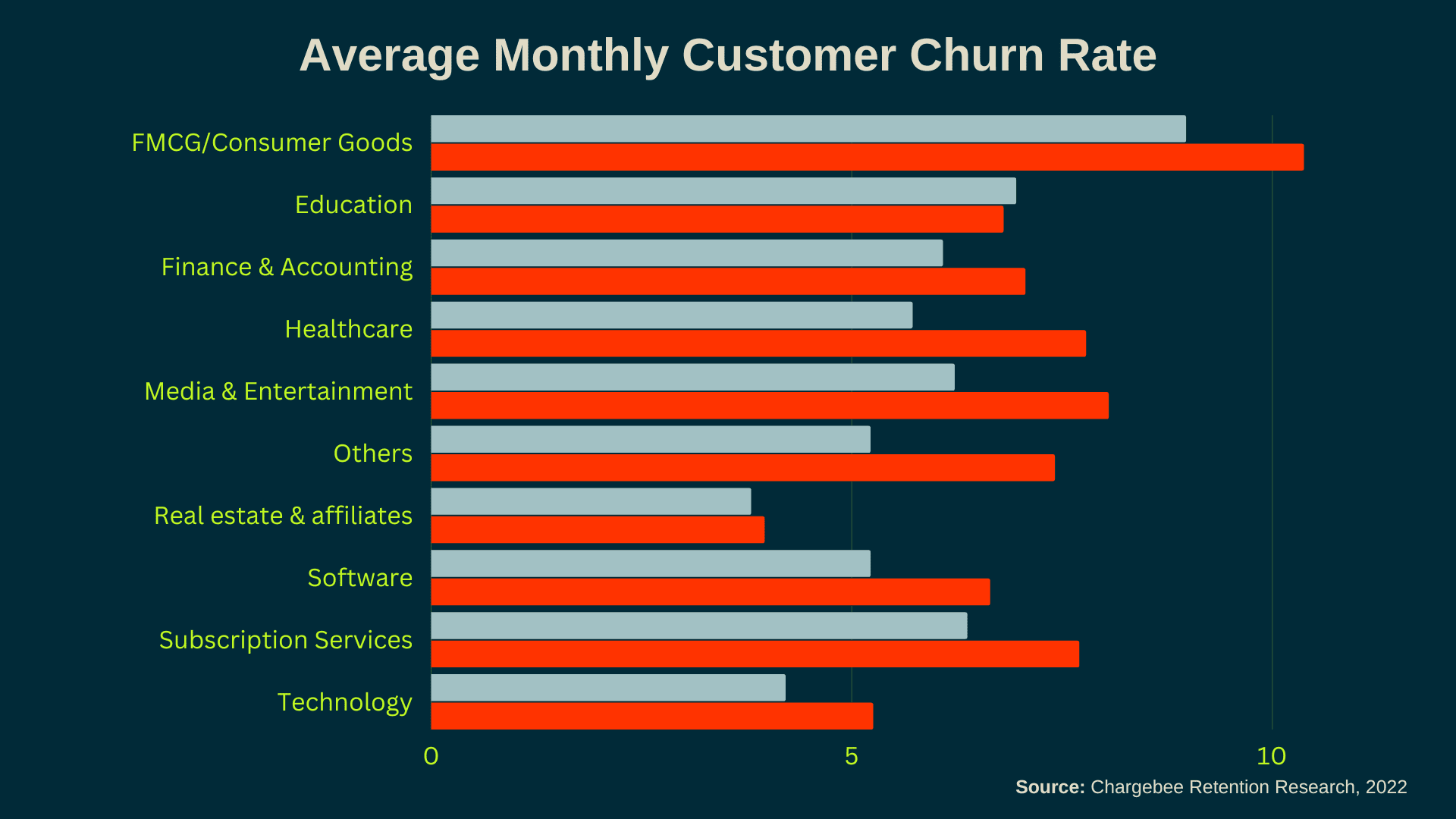
“SaaS businesses that aim to achieve higher growth put as much attention into caring for existing customers as they do into acquiring new ones, investing in specific post-sales constructs to increase cross-sell, upsell, and retention with the right talent, tools, and analytics. These efforts, combined with strong pricing and product support, result in median net retention rates (NRR) of 120 percent or more—which means these businesses can deliver 20 percent growth every year without adding a single new customer.”
– Paul Roche and Sid Tandon, McKinsey & Co. (2021)
3. There’s more to experiment with than your product
Modern products operate on the Red Queen principle – the idea that you must continuously improve the product to retain the same value for users. It acknowledges the fluidity of customer expectations – i.e., customer needs and, by extension, their ‘value drivers’ are constantly changing; hence, the product has to keep up.
Your customers don’t view you as a tool; they view you as an aggregate of components brought together to solve a problem. Hence, pricing, onboarding, payments, experience management – everything is a part of your product package.
It is unfair, therefore, to only experiment with and optimizes features without equally obsessing over the smaller components that can often drive enormous impact. To put this in perspective, let’s take a look at a more recent, frontier-breaking internet-numbing innovation – ChatGPT.
“The AI models behind ChatGPT existed for 12 to 24 months. Outside of small groups, they only got a little attention. ChatGPT gave people access to those models through a simple user interface.”
– Kieran Flanagan, CMO, Zapier
ChatGPT didn’t reinvent the technology. It reinvented accessibility. Suddenly, AI wasn’t only appealing to tech-geeks; it was equally exciting for school-going, internet-savvy kids. In December 2022, Sam Altman, Founder of OpenAI (the parent company), projected a $1 billion revenue target for 2024. Small change. Huge impact.
Minor changes to the individual components – like pricing your product, onboarding, and even your customer retention workflows – can move the needle for your business. For example, OpenView found that 61% of SaaS businesses surveyed had adjusted their pricing last year, leading to an average 27% improvement in ARR.
This increasing visibility on pricing impact is also tricking down into business conscience, with 85% of respondents telling a Chargebee survey they intend to keep their pricing iterative.
Related Reads:
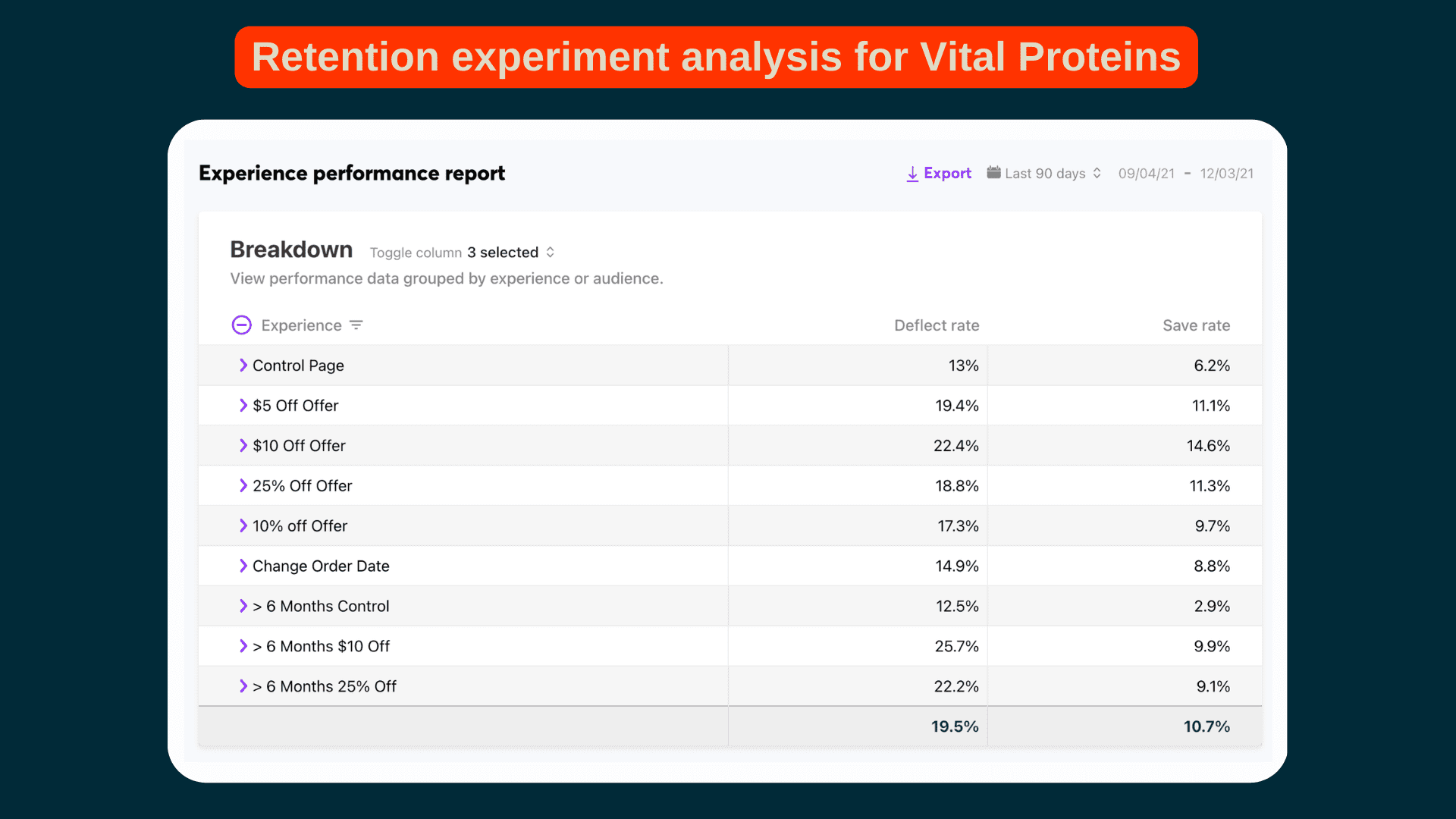
However, iterating on pricing, plans, or coupons to see what sticks is easier said than done. Especially at the very early stages, your ability to adapt to market dynamics, identify changes that matter, and optimize them helps build long-term competitive advantage.
At Chargebee, we recognize the importance of addressing change. It is why, while Chargebee built the necessary infrastructure for businesses to experiment with plans, pricing, cancel pages, coupons, and more, We support 67+ pricing experimentation modules and multiple business models and even integrate with various payment gateways across 150+ countries to do revenue experiments for our customers a breeze with our dashboard capabilities that quantify ROI in plain vanilla.
“Chargebee Retention allowed us to test and improve a neglected part of our flow quickly. No other tool allows for quick testing of 5 different offers to all customer groups and targeting those offers to specific groups for optimization.”
– Emily Keyser, (Former) Director of eCommerce Program Management, Vital Proteins
Growth = obsession + discipline
Conduct a timeline analysis for any business; you will see that growth is more a linear function than a dot. It is often the same organizational discipline, repeated over and over, often at the expense of looking redundant, that trains you for growth. It was the same for Nike.
When Blue Ribbon hired its first employee – Jeff Johnson was tasked with doing just one thing. Sell shoes. Jeff sold 3,250 pairs of shoes in the first ten months, which Phil Knight remarked was “completely impossible.”
His trade secret wasn’t so much a secret as Business #101 – relationships. How he built relationships, however, was commendable.
“Every time Johnson sold a pair of shoes, he’d create an index card for that customer. He’d jot down all minutiae details: shoe size, preference, favorite distance, etc.
Johnson used this handcrafted database to keep in touch with customers. He’d send birthday cards, training tips, and notes of encouragement before big races.
Customers would write back, telling him about their lives, injuries, and troubles. Johnson had hundreds upon hundreds of customer pen pals. He had created the modern-day mailing list but with a response rate of 95%.”
– Harry’s Marketing Examples
Was building a manual mailing list for a growing customer list in the thousands and remembering every detail easy? No. Johnson did it anyway.
As an early-stage business, growth may not exist in the more minor things. Nitpicking details to inflict a 1% improvement, fixing your tech stack, or constantly experimenting – i.e. (according to Paul Graham), doing things that don’t scale might look laborious. Yet, every major company had to learn how to swing a bat before they could hit a home run on growth.
“The question to ask about an early-stage startup is not “Is this company taking over the world?” but “How big could this company get if the founders did the right things?” And the right things often seem both laborious and inconsequential at the time. Microsoft couldn’t have seemed very impressive when it was just a couple of guys in Albuquerque writing Basic interpreters for a market of a few thousand hobbyists (as they were called then). Still, in retrospect, that was the optimal path to dominating microcomputer software. And I know Brian Chesky and Joe Gebbia didn’t feel like they were en route to the big time as they were taking “professional” photos of their first hosts’ apartments. They were trying to survive. But in retrospect, that was the optimal path to dominating a big market.”
– Paul Graham, on Doing Things That Don’t Scale
More importantly, doing fundamental, ‘drop-in-the-ocean’ things might not feed the instant gratification monkey, but if James Clear is anything to go by – inflicting 1% change every day can make you 37X better by the time you are done.
Customers reward thoughtfulness. Sometimes this means going the extra mile – fiddling with every product component, painstakingly crafting every detail, and obsessing about foundational architecture. It is not always easy but almost always worth the effort.
Bridget Harris, who built YouCanBook.me – a profitable, bootstrapped, multi-million dollar scheduling tool shared the joys of “delivering small things repeatedly over time with great people” in one of our community conversations.
The question to ask yourself is, are you ready to solve the small, to be big?

